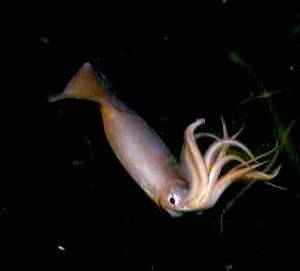Humboldt Squid
Dosidicus gigas
Online Biology Dictionary
 Humboldt squid, Cordell Bank National Marine Sanctuary, 2005.
Humboldt squid, Cordell Bank National Marine Sanctuary, 2005.
|
|

|
| Dosidicus gigas |
The Humboldt Squid (Dosidicus gigas), also known as the Jumbo Squid, reaches a weight of 50 kg (~110 lbs) and travels in shoals that may contain in excess of a thousand individuals. D. gigas was first described by the renowned naturalist Alexander von Humboldt.
Many reports exist of these aggressive carnivores attacking human beings, particularly divers and fishermen. The suckers lining their tentacles have sharp teeth that tear prey as it is drawn to the sharp beaklike mouth. These squid are also cannibalistic, attacking and eating members of even their own shoal showing signs of disability.
Like many cephalopods, they can change the color of their skins. During attacks on fisherman they have been reported to flash alternately between white and red, behavior that has given them their Spanish nickname, Diablo Rojo (Red Devil).
Distribution of the Humboldt squid's
D. gigas was once found only off the western coasts of South and Central America, but it has now expanded its range north as far as Puget Sound.
An inspiration for fiction?
The tendencies of D. gigas to travel in large shoals and to come close inshore and attack humans may have inspired H. G. Wells' short story The Sea Raiders in which a retired tea dealer by the name of Fison, vacationing on the southern coast of England at Sidmouth, witnesses several gristly attacks by large man-eating squid. He first sights large squid feeding on a human body near rocks offshore but cannot reach the site. He then gets help and while they're rowing out to fetch in the body, they're attacked. One of their number is overpowered, engulfed in masses of tentacles, and dragged from the boat. Fison and the others in his boat escape, but then realize that another small boat they had seen further out, occupied by three women and a child, had not.
Class Cephalopoda.
Cephalopods are mollusks (that is, they belong to Phylum Mollusca). They differ from other mollusks primarily in having tentacles. They are exclusively marine. None of them — with the exception of the Atlantic Brief Squid, Lolliguncula brevis, which is found in Chesapeake Bay — can tolerate even brackish water. There are two types of cephalopods living today, the nautiloids (Nautilus and relatives) and members of Subclass Coleoidea (octopuses, squid and cuttlefish) Cephalopods are bilaterally symmetric and have a prominent head. All, with the exception of nautiloids and deep-sea octopuses (Cirrina), can release ink, which they do when threatened. For this reason they are known as inkfish. Cephalopods have a high brain-body ratio and may be the most intelligent of all invertebrates.
About Alexander von Humboldt >>
Most shared on Macroevolution.net:
Human Origins: Are we hybrids?
On the Origins of New Forms of Life
Mammalian Hybrids
Cat-rabbit Hybrids: Fact or fiction?
Famous Biologists
Dog-cow Hybrids
Georges Cuvier: A Biography
Prothero: A Rebuttal
Branches of Biology
Dog-fox Hybrids